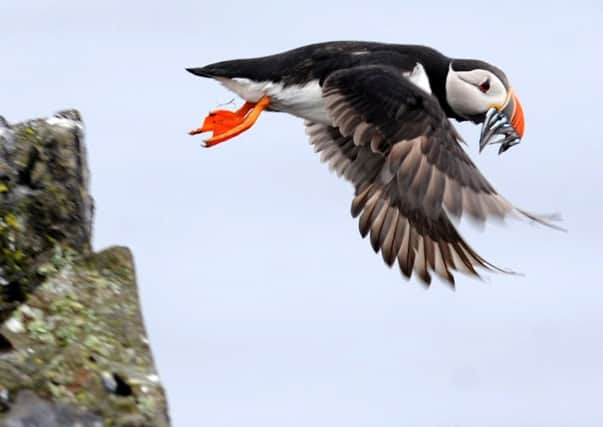Seabird census urged as fears grow for puffins


The birds are facing challenges such as climate change, pollution, over fishing and wind farms.
Professor Mike Harris, emeritus research fellow at the Centre for Ecology and Hydrology in Edinburgh, said that while the 2000 seabird census revealed Scotland had half a million pairs of puffins, with an additional 1000,000 pairs breeding elsewhere in Britain and Ireland, anecdotal evidence is pointing to a big decline in numbers in northern and western colonies since then.
Advertisement
Hide AdAdvertisement
Hide AdProf Harris who will give the first Dr Bryan Nelson Memorial Lecture, titled “The Puffin: Past Present and Future”, hosted by the Scottish Seabird Centre and RSPB Scotland at Edinburgh Napier University’s Craiglockhart campus on Thursday, said: “There are no accurate counts for half the Scottish puffin population.
“The birds’ habit of burrowing and living in underground nests means they are difficult to count and would require a labour intensive census to actually count the number of burrows. An additional problem is that some of the islands in the west coast, such as those in the St Kilda group which has 25 per cent of British puffins, are difficult to get to. Elsewhere puffins nest under boulders at the bottom of cliffs where burrows are difficult to see.”
Prof Harris, who has conducted extensive research for over 40 years on the Isle of May in the Firth of Forth, will also give new insights from his research into the future of puffins.
Dr Nelson, who died last year, was a world expert on gannets. He spent three years in a hut on the Bass Rock off North Berwick researching gannets in the 1960s.
Tom Brock, chief executive of the Scottish Seabird Centre, said: “The aim of the lecture is to celebrate and continue what Bryan did so successfully – enthusiastically sharing insights and research into the natural world – while also ensuring that his passion for wildlife lives on.”
Stuart Housden, director of RSPB Scotland, said that with so many of Scotland’s seabirds in trouble the lecture was a fitting tribute.
A Scottish Government spokeswoman said: “Research published only this week provided a stark reminder of the many, complex challenges facing Scotland’s world-renowned seabird populations.
“Our seabird colonies are of global importance but we are not alone in facing these challenges. The Joint Nature Conservation Committee is working on a revised proposal for a seabird census. Once complete, that proposal will be submitted to all the UK administrations with a view to securing funding. We will give that proposal careful consideration and would urge other organisations to contribute funding too.”